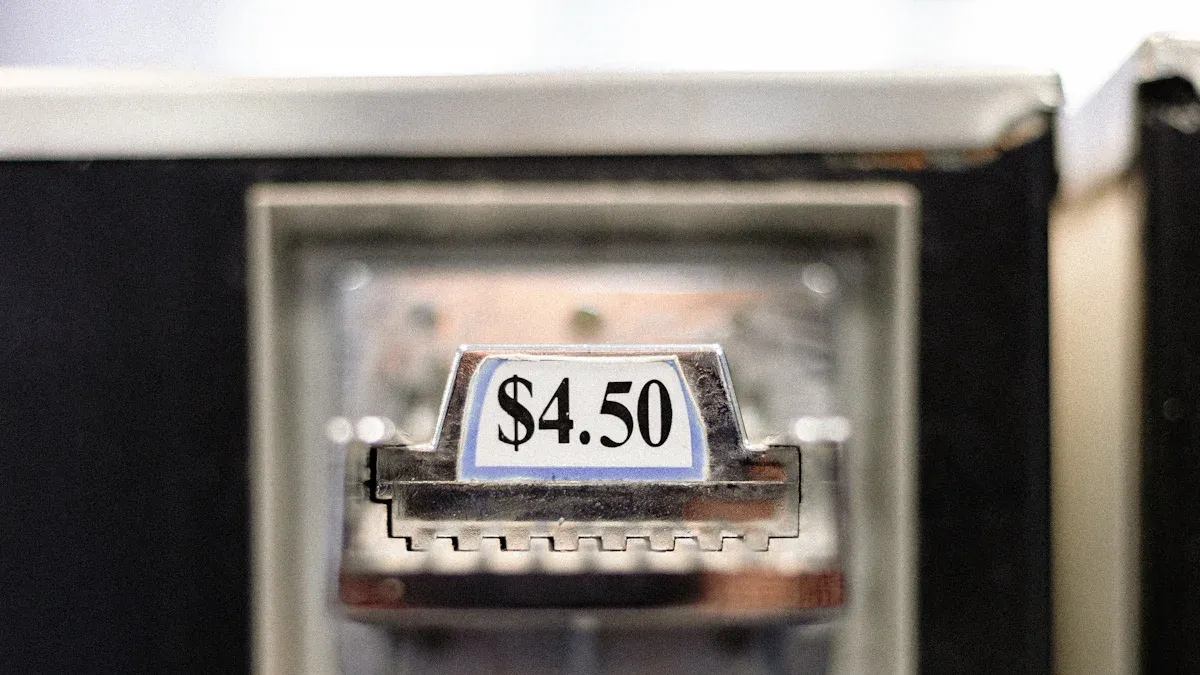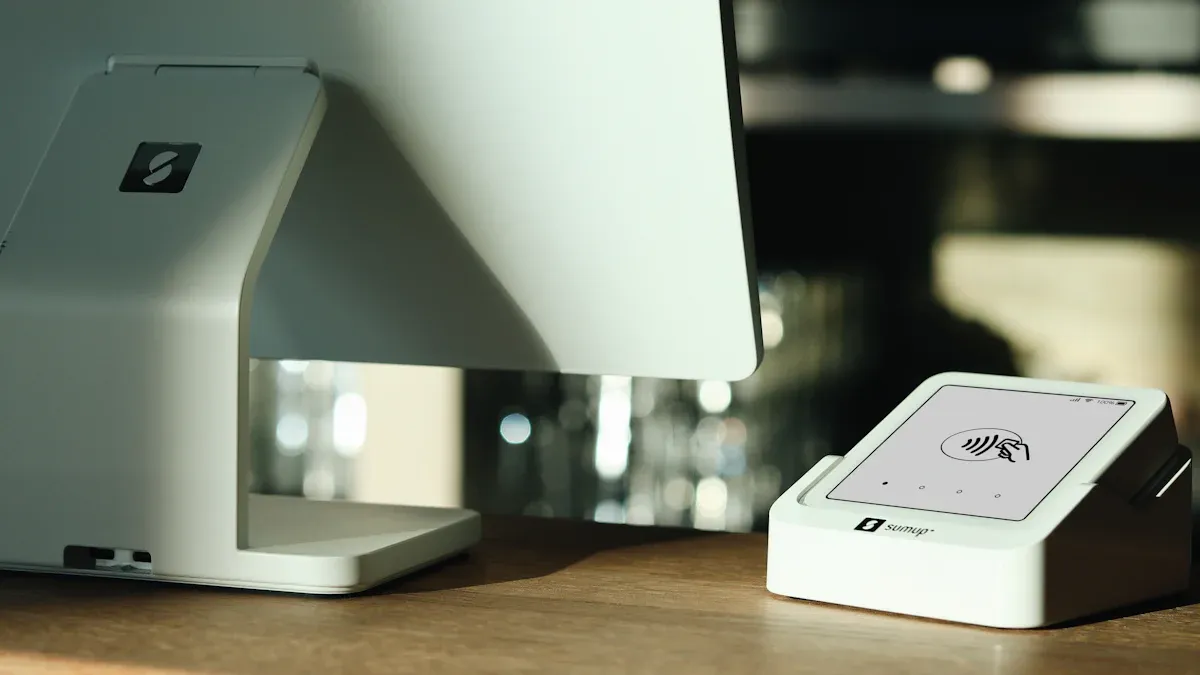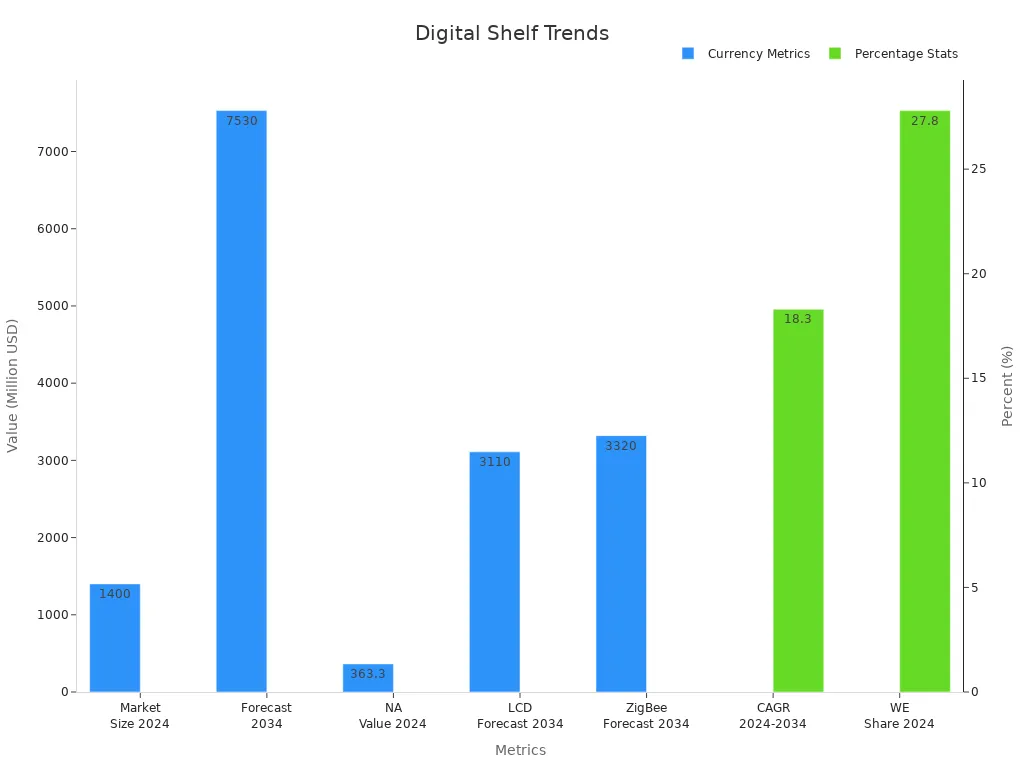
Retailers have embraced digital shelf tags to enhance store operations and improve customer engagement. The global Electronic Shelf Labels market reached $1.56 billion in 2023, with projections indicating strong growth. North America leads this trend, supported by advanced retail infrastructure and technologies like ESL Gateway AP and ESL Price Tag.
- Stores using digital shelf labels experienced a 31.8% increase in customer engagement.
- Digital shelf signs influence 70% of buying decisions. Esl Retail now benefits from real-time updates, automation, and eco-friendly solutions, challenging traditional shopping habits.
Retailer Experiences with Digital Shelf Tags

Operational Efficiency with Digital Shelf Labels
Streamlining Price Updates for Retailers
Retailers have transformed their price management processes by adopting digital shelf labels. Manual price changes once required hours of staff labor and often led to errors or inconsistencies. Now, stores can update prices across thousands of products instantly and accurately. For example, Intermarche uses Pricer’s 4-color electronic shelf labels to execute campaigns and display product information efficiently. Silicon Labs highlights how automated, real-time price updates reduce labor costs and minimize pricing errors. REWE, a major European retailer, implemented a secure wireless system that links digital shelf labels to POS data, enabling dynamic pricing and improving the overall shopping experience.
Simplifying Inventory Management Processes
Digital shelf labels play a crucial role in inventory management. Retailers can link multiple products to a single tag, display real-time stock levels, and even show customer reviews or promotions. Product position tracking through infrared technology supports planogram compliance and optimizes services like BOPIS (Buy Online, Pick Up In Store) and curbside pickup. SmartFlash technology guides order pickers visually, speeding up the process and reducing mistakes. NFC and QR codes on tags provide instant access to stock and savings information, further streamlining inventory management. AI-powered Shelf Vision cameras monitor shelf stocking, detect gaps, and ensure compliance, which enhances operational efficiency.
Research in the UK and EU shows that electronic shelf labels help retailers reduce overstock and food waste. When combined with inventory tracking, these systems nearly eliminate food waste and reduce the need for last-minute supply purchases, excess manufacturing, and inefficient warehousing.
Real-Time Pricing and Promotions Using Digital Shelf Tags
Dynamic Price Adjustments in Retail Environments
Digital shelf labels enable retailers to implement dynamic pricing strategies. Stores can adjust prices instantly based on demand, competitor pricing, or product expiration dates. This flexibility allows for optimized inventory turnover and reduced waste. For instance, Carrefour in Poland uses digital shelf labels to update prices in real time, while Zabka adjusts prices according to foot traffic and sales trends. Walmart leverages advanced algorithms to monitor competitor prices and maximize profits. Tesco integrates dynamic pricing with loyalty program data, offering targeted discounts and increasing customer loyalty.
| Retailer | Evidence Type | Operational/Financial Impact |
|---|---|---|
| Carrefour (Poland) | Empirical case study | Instantaneous price updates, optimized inventory turnover, reduced waste, enhanced customer satisfaction |
| Zabka (Poland) | Operational experiment | Dynamic pricing based on foot traffic and sales trends, improved sales optimization and profitability |
| Walmart (USA) | Operational strategy | Competitor price monitoring, dynamic price adjustments, profit maximization |
| Tesco (UK) | Operational integration | Dynamic pricing linked to loyalty data, targeted discounts, increased loyalty and sales |
| UK & EU studies | Empirical research | ESLs used for markdowns, reduced overstock and food waste, near elimination of food waste with inventory tracking |
| China study | Operational statistics | Reduced last-minute supply purchases, excess manufacturing, overtime labor, inefficient warehousing |
Responsive Promotional Strategies Enabled by Digital Shelf Labels
Retailers can launch and manage promotions with unprecedented speed and accuracy. Flexible digital shelf labels allow for instant updates to promotional messaging, ensuring consistency across all stores. Intermarche’s use of Pricer’s ESLs demonstrates how retailers can enhance campaign execution and display detailed product information. Real-time updates support centralized control, saving staff time and reducing the risk of outdated promotions. These capabilities help retailers respond quickly to market trends and customer preferences.
A field experiment found that digital shelf labels significantly reduce the cost of price adjustments and minimize pricing errors. These improvements support more effective promotional strategies and enhance the store’s image.
Challenges for Retailers Adopting Digital Shelf Tags
Implementation Costs and Budget Considerations
- High upfront costs for deploying digital shelf labels remain a significant barrier, especially for smaller retailers with limited budgets.
- Retailers must invest in hardware such as e-paper labels, batteries, and communication systems, which increases the initial financial burden.
- Ongoing maintenance, training, and support add to the total cost of ownership.
Technical Integration and Ongoing Maintenance
- Integration with existing POS and inventory management platforms can be complex and resource-intensive.
- Maintenance and upgrading of digital shelf label systems require technical expertise and ongoing investment.
- Larger retail chains may offset these costs through long-term labor savings and operational efficiencies, but smaller retailers often struggle with financial and technical demands.
Staff Training and Adaptation to Digital Shelf Labels
- Staff must adapt to new workflows and technologies, which can require significant training.
- Ongoing support is necessary to ensure that employees use digital shelf labels effectively.
- Despite these challenges, many retailers continue to adopt digital shelf labels due to the long-term benefits of labor cost savings, pricing accuracy, and improved operational efficiency.
Customer Experience with Digital Shelf Tags

Shopping Convenience and Digital Shelf Labels
Enhanced Price Transparency for Shoppers
Digital shelf labels have transformed the way shoppers access pricing information. Customers now see real-time price updates directly on the shelf, which reduces confusion and eliminates discrepancies between shelf and register prices. This transparency builds confidence in the shopping process. Market reports highlight that digital shelf labels provide accurate, up-to-date pricing, which directly improves customer satisfaction. Shoppers benefit from knowing that the price displayed is always current, even during rapid promotional changes or markdowns.
- Digital shelf labels enable real-time price updates, reducing manual errors.
- Technologies such as RF and NFC ensure reliable and secure data transmission, supporting large and small retail formats.
- Retailers can respond quickly to market changes, ensuring customers always see the correct price.
A consumer survey involving over 300 participants found that digital shelf labels significantly improve shopping convenience. Shoppers appreciate the ability to access automated and detailed product information, which streamlines their decision-making process and enhances their overall experience in the store.
Access to Detailed Product Information via Digital Shelf Tags
Digital shelf labels offer more than just pricing. They provide instant access to detailed product information, including ingredients, nutritional facts, and even customer reviews. NFC technology allows shoppers to tap their smartphones on a label to receive personalized promotions or additional product details. This feature supports a more informed shopping journey and increases engagement.
- Digital shelf labels display product details, stock levels, and promotional offers.
- Integration with retail systems ensures that information remains accurate and consistent across all channels.
- Shoppers can quickly compare products, leading to more confident purchasing decisions.
The same consumer survey revealed that enhanced product information positively influences psychological well-being and postpurchase behaviors. Women, in particular, place higher value on the depth of information provided by digital shelf labels, which leads to increased satisfaction and loyalty.
Trust and Perception of Digital Shelf Tags
Customer Reactions to Dynamic Pricing
Dynamic pricing, enabled by digital shelf labels, introduces new behaviors in the retail environment. Customers notice price changes happening in real time, which can prompt both curiosity and skepticism. High-quality, consistent product listings on digital shelf labels convey professionalism and attention to detail, which increases trust. Centralized product information management ensures accuracy and prevents errors that could harm consumer confidence.
- Consistent branding and accurate information across all channels improve brand perception.
- Customer reviews displayed on digital shelf labels act as social proof, influencing purchasing decisions.
Retailers who manage reviews and respond to feedback build long-term loyalty and trust. Omnichannel strategies that use digital shelf labels reinforce a seamless and trustworthy customer experience.
Perceived Fairness and Reliability of Digital Shelf Labels
Shoppers expect fairness and reliability from digital shelf labels. When prices update transparently and product information remains consistent, customers perceive the system as fair. Any discrepancies or errors can quickly erode trust. Retailers must maintain high standards for accuracy and reliability to support positive perceptions.
- Accurate digital shelf labels prevent confusion and ensure customers feel treated fairly.
- Reliable updates and clear communication foster a sense of trust in the technology.
Challenges for Customers Using Digital Shelf Tags
Navigating New Technology in Retail Stores
While digital shelf labels offer many benefits, some customers face challenges when interacting with new technology. Technical integration issues, such as connectivity problems or display malfunctions, can disrupt the shopping experience. Staff resistance and training gaps may also impact how effectively customers receive assistance.
- Connectivity issues, including dead zones, may cause missed price updates.
- Hardware failures, such as display malfunctions or battery depletion, can create confusion.
Retailers must address these challenges to ensure a smooth transition for all shoppers.
Learning Curve and Potential Confusion
Adapting to digital shelf labels requires a learning curve for some customers. Not everyone feels comfortable using NFC or scanning QR codes for additional information. System downtime or inconsistent updates may lead to uncertainty about pricing or product details.
- Staff spend significantly less time updating prices, but customers may need guidance during the transition.
- Pricing errors decrease, but system reliability becomes critical for maintaining trust.
Retailers should provide clear instructions and support to help customers navigate these changes.
Accessibility and Inclusivity Concerns with Digital Shelf Tags
Accessibility remains a key consideration for digital shelf labels. Some customers, such as older adults or those with visual impairments, may struggle to read electronic displays or use smartphone-based features. Inclusivity requires thoughtful design and ongoing evaluation.
- Ongoing maintenance, including battery management and technical support, ensures digital shelf labels remain accessible.
- Security risks, such as hacking or tampering, require strong safeguards to protect both retailers and customers.
Retailers must prioritize accessibility and inclusivity to deliver a positive customer experience for everyone.
How Digital Shelf Tags Challenge Old Shopping Habits
Shift from Static to Dynamic Pricing with Digital Shelf Labels
Impact on Traditional Price-Checking Routines
The introduction of digital shelf labels has transformed how shoppers check prices in stores. In the past, customers relied on static paper tags, which often led to confusion when prices at the register did not match those on the shelf. Now, digital shelf labels update prices instantly and accurately, reducing errors and improving trust. Major retailers like Amazon, Walmart, and Carrefour have adopted these systems to streamline operations and enhance the shopper experience. Digital shelf labels use wireless technologies and centralized data management, allowing stores to synchronize prices across locations. This shift eliminates manual price changes and supports real-time updates, making price-checking routines more efficient and reliable.
Changes in Deal-Hunting and Bargain-Seeking Behavior
Digital shelf labels have also changed how shoppers hunt for deals. Recent research shows that consumers now use smartphones alongside digital shelf labels to compare prices and find bargains. The integration of mobile technology with digital shelf labels enables real-time price comparisons, which increases engagement and confidence. Shoppers benefit from synchronized online and in-store prices, reducing the need for showrooming. Enhanced visibility of unit prices on digital shelf labels encourages customers to make more informed choices and seek out better deals, especially during periods of economic uncertainty.
Changing In-Store Behaviors Due to Digital Shelf Tags
New Interactions with Shelves and Product Displays
Digital shelf labels encourage new ways for customers to interact with shelves and displays. Shoppers can access detailed product information, such as ingredients or stock levels, directly from the shelf label. Some digital shelf labels include NFC or QR codes, allowing customers to use their smartphones for additional details or personalized offers. This interactive approach creates a more engaging and informative shopping experience.
Evolving Roles and Responsibilities for Store Staff
Store staff roles have evolved with the adoption of digital shelf labels. Employees now focus less on manual price changes and more on customer service and inventory management. Staff monitor the accuracy of digital shelf labels and assist customers with new technologies. This shift allows stores to allocate resources more efficiently and improve overall service quality.
Adapting to a Digital Shopping Environment
Building Trust in Digital Shelf Labels and Displays
Trust plays a crucial role as shoppers adapt to digital shelf labels. Accurate and timely price updates build confidence in the system. Studies show that clear and reliable information on digital shelf labels increases customer satisfaction and supports positive purchase decisions. Retailers must maintain high standards for data accuracy to foster long-term trust.
Embracing Technology in Everyday Shopping Experiences
Customers increasingly embrace technology in their shopping routines. Surveys reveal that digital shelf labels, along with other digital tools, reshape how people make purchase decisions. These technologies disrupt traditional shopping journeys by enabling direct transitions from awareness to action. Both younger and older shoppers adapt to these changes, showing that digital shelf labels have a broad impact on consumer behavior.
The Future of Digital Shelf Tags in Retail
Trends in Digital Shelf Label Adoption
Growing Demand Among Retailers
Retailers worldwide continue to increase their investment in digital shelf labels. Europe led the electronic shelf label market in 2023, holding a 38% share. Major retailers such as Carrefour, Metro AG, and Tesco have adopted these systems to improve price accuracy and operational efficiency. Government initiatives and retail infrastructure upgrades support this growth, especially in Europe. The Asia-Pacific region is expected to see rapid expansion, driven by urbanization and retail growth in countries like China, Japan, and South Korea. Companies such as SES-imagotag, Pricer AB, and Samsung Electro-Mechanics drive innovation in this space. Advancements in wireless transmission and battery life, as seen in M2COMM’s and SoluM’s recent projects, further accelerate adoption.
| Attribute | Details |
|---|---|
| Market Size (2024 Estimate) | USD 1.4 Billion |
| Forecasted Market Value (2034) | USD 7.53 Billion |
| Compound Annual Growth Rate (CAGR) | 18.3% (2024 to 2034) |
| Western Europe Market Share (2024) | 27.8% |
| North America Market Value (2024) | USD 363.3 Million |
| LCD Segment Value (2034 Forecast) | USD 3.11 Billion |
| ZigBee Segment Value (2034 Forecast) | USD 3.32 Billion |

Key growth drivers include retail automation, IoT integration, and the need for real-time pricing. Retailers seek to optimize workflows and improve pricing accuracy. However, regular software updates and maintenance remain ongoing challenges.
Integration with Omnichannel Retail Strategies
Digital shelf labels now play a central role in omnichannel retail strategies. Retailers synchronize these labels with online pricing and inventory systems, ensuring consistency across physical and digital channels. Integration approaches combine hardware, software, and services to enable seamless updates and data flow. Technologies such as RF, NFC, and IoT protocols support real-time data sharing and consumer engagement. As retailers expand into emerging markets, the integration of digital shelf labels with retail management systems streamlines price adjustments, promotions, and inventory checks.
Innovations in Customer Experience with Digital Shelf Tags
Personalized Offers and Promotions
Retailers use AI-based recommendation systems and predictive analytics to deliver personalized offers through digital shelf labels. These systems analyze purchase history and browsing behavior to suggest relevant products. Studies show that personalized product suggestions can increase sales by up to 30%. Dynamic pricing and real-time inventory synchronization ensure that offers remain relevant and available, which boosts interaction and conversion rates. AI-powered personalization has doubled engagement rates and increased conversion rates by up to 1.7 times for some retailers.
Enhanced Engagement Through Digital Shelf Labels
Digital shelf labels now feature interactive displays, NFC, and QR codes, allowing shoppers to access detailed product information and participate in loyalty programs. Interactive content, such as touchscreens and gamified experiences, transforms passive shoppers into active participants. Studies indicate that these features can increase product interaction by up to 60% and boost engagement by up to 58%. Retailers deliver targeted recommendations, timed discounts, and loyalty rewards, all enabled by real-time data and customer behavior tracking. These innovations create a more engaging and personalized shopping experience.
Digital shelf tags have reshaped retail by enabling real-time pricing and improving operational efficiency. Retailers now achieve greater accuracy and cost savings, while customers enjoy richer product information and a more transparent shopping experience. Some challenges remain, including initial investment and adaptation. Those who embrace this technology position themselves for long-term success in a rapidly evolving retail landscape.
FAQ
What are digital shelf tags?
Digital shelf tags are electronic displays that show product prices and information on retail shelves. Retailers update these tags remotely using wireless technology. The system replaces traditional paper price labels and supports real-time pricing.
How do digital shelf tags improve store operations?
Digital shelf tags automate price updates and reduce manual labor. Staff spend less time changing labels and more time assisting customers. The system also helps maintain accurate pricing and inventory information across all store locations.
Are digital shelf tags secure?
Retailers use encrypted wireless networks and secure protocols to protect digital shelf tag systems. Regular software updates and monitoring help prevent unauthorized access or tampering. Security remains a top priority for technology providers.
Can digital shelf tags display more than just prices?
Yes. Digital shelf tags can show product details, stock levels, promotions, and QR codes. Some models support NFC, allowing shoppers to access additional information or personalized offers using their smartphones.
What challenges do retailers face when adopting digital shelf tags?
Retailers often encounter high upfront costs, technical integration issues, and the need for staff training. Ongoing maintenance and system updates also require attention. Smaller retailers may find these challenges more difficult to manage.
How do digital shelf tags affect customer experience?
Digital shelf tags provide real-time price accuracy and detailed product information. Shoppers benefit from increased transparency and convenience. Some customers may need time to adapt to the new technology, especially when using features like QR codes or NFC.
Are digital shelf tags accessible for all shoppers?
Retailers design digital shelf tags with accessibility in mind. However, some shoppers, such as older adults or those with visual impairments, may face challenges. Ongoing improvements aim to enhance readability and usability for everyone.
Will digital shelf tags become standard in all stores?
Industry trends suggest that digital shelf tags will see wider adoption, especially in large retail chains. Market growth, technological advances, and demand for real-time pricing drive this shift. Smaller stores may adopt the technology as costs decrease.


